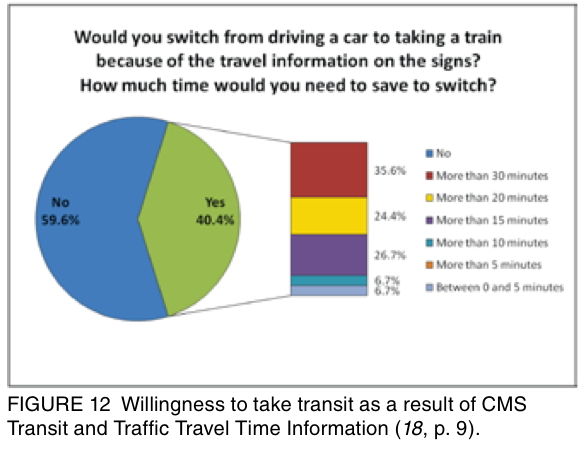TRANSIT COOPERATIVE RESEARCH PROGRAM
Introduction
Project Backgrounds and Objectives
 The primary focus of the Synthesis is on determining the experience that transit agencies have had with deploying electronic signage to provide transit information in the United States and abroad, and the process that agencies are using to decide to deploy information through this dissemination channel to serve the needs of their customers.
The primary focus of the Synthesis is on determining the experience that transit agencies have had with deploying electronic signage to provide transit information in the United States and abroad, and the process that agencies are using to decide to deploy information through this dissemination channel to serve the needs of their customers.
In the past 15 years, electronic signage displaying static and real-time transit information has been deployed by transit agencies throughout the United States and abroad. Various sign types [e.g., light-emitting diode (LED), liquid crystal display (LCD)] are available for installation at transit stops and stations, as well as nontraditional locations such as office buildings and shopping malls. Although transit information is increasingly provided on mobile phones and smartphones, agencies recognize that electronic signage has independent utility. Further, because many transit customers do not have mobile devices, electronic signage is an important channel through which vital transit information is conveyed to the public.
Further, as discussed in TCRP Synthesis 91 (1), public transit customers have relatively high expectations for real-time information at all stages of their trips. It has been observed that mobile devices do not always operate in transit stations where there may be no cellular communication coverage. Even if coverage exists, it is faster to look at signage rather than access a mobile phone, open the appropriate application, enter the right information (if necessary), and wait for the results. In addition, electronic signage can provide useful information to customers, resulting in positive customer satisfaction and a potential improvement in the overall agency image. As a result, electronic signage provides the opportunity to provide transit information to customers at stops and stations regardless of mobile device ownership.
This Synthesis examines and documents the state of the practice in the use and deployment of electronic signage using the following five elements. The first is the underlying technology required to generate the information that will be disseminated on the signage. This element covers the required underlying software, hardware, and communications. The second is the signage technology, including the type of display (e.g., LED, LCD) and other characteristics such as the information that can be displayed on specific display types (e.g., characters only, characters and pictures). The third covers the characteristics of the information dis- played on the signage, including message types, content, format, and accessibility; the use of standards; and the reliability and accuracy of the displayed information. The fourth covers the resources required to successfully deploy and manage electronic signage, including capital and operations and maintenance costs, and agency staff requirements. The fifth and final element is the decision process that is used to decide if signage will be deployed, where it will be located, and what it will display, as well as the contribution of electronic signage at stops and stations to an overall agency communications strategy, including “information equity.” Information equity is defined as providing real-time information through at least two dissemination media, and in both audio and visual formats.
A review of the relevant literature is combined with surveys of selected transit agencies and other appropriate stakeholders in order to report on the current state of the practice. Based on survey results, four case examples or profiles were developed to describe innovative and successful practices, as well as lessons learned and gaps in information.
Read full report (PDF) here: Use of Electronic Passenger Information Signage in Transit
About The Transit Cooperative Research Program (TCRP)
www.tcrponline.org
“The Transit Cooperative Research Program is your ticket to information central. Whether you are a service provider, consultant or supplier, TCRP provides the tools you need to innovate and solve problems in the transportation industry. The information you need is easily accessible through print, CDs, and online. And best of all — it’s free through APTA!”
Tags: Electronic, Passenger Information, Signage, TCRP, Transit, TRB







 RSS Feed
RSS Feed